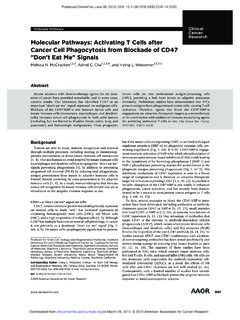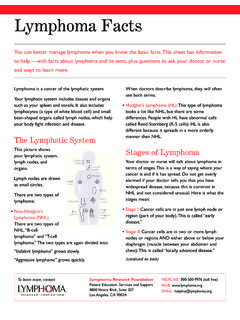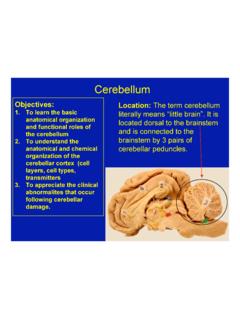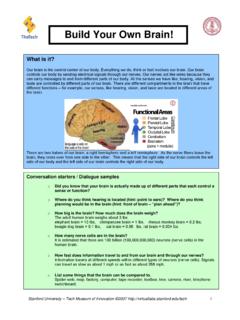Transcription of Epigenetic Regulation, Stem Cells and Cancer
1 Epigenetic Regulation, stem Cells and Cancer Rudolf Jaenisch Whitehead Institute and Dept. of Biology, MIT, Cambridge, MA. Development and Differentiation Genetic or Epigenetic changes? Levinson and Sweatt, 2005. Genetics vs. Epigenetics Maintenance of DNA methylation and histone modification Felsenfeld, 2007. Histone Modifications Allis, Jenuwein, Reinberg, 2007. One Genome, many Epigenomes Allis, Jenuwein, Reinberg, 2007. Three Definitions of Epigenetics 1. Transmission of information through meiosis or mitosis that is not based on DNA sequence 2. A mechanism for stable maintenance of gene expression states that involves physically marking . the DNA or its associated proteins 3. Mitotically or meiotically heritable changes in gene expression that are not coded in the DNA itself Relevant for development and Cancer Epigenetic Regulation, a mechanism that allows the genome to integrate intrinsic with environmental signals Epigenetics and Disease Relevance Diet / environment alters Epigenetic state of genome and may affect incidence of long latency / late stage diseases such as: Cancer Neuro-degenerative diseases Gene expression affected by diet?
2 Pseudoagouti Allele: Mice with Variable Coat Color Agouti gene (A): brownish coat of wild mice AI Aallele: P insertion of IAP retroelement coat variegates between yellow and wild type color depends on methylation of IAP. Expression (phenotype). A allele (wt): Skin AI A Pallele, ** } normal methylated IAP Skin AI A Pallele, b iquitous: U. u n -methylated IAP yellow, obese, tumors Environmental and Epigenetic changes: short-term and long-term outcomes Turner, 2007. Epigenetics, Environmental Stimuli and Disease: A few questions How does diet affect long latency diseases? Diet strongly affects Cancer incidence -- Mechanisms? How about neurodegenerative diseases such as AD, Parkinson's? -- Not a clonal disease: how to study? Nuclear Cloning, stem Cells and Epigenetic Reprogramming Relevance for transplantation therapy Medical Challenges and the Potential of stem Cells Increasing population age: Alzheimer, Parkinson, heart failure.
3 Potential solution: Regeneration, tissue repair Problem: Suitable donor Cells Tissue Repair by Cell Transplantation: Historical Perspective Bone marrow transplantation Established medical treatment since the 70s to treat leukemia Problem: finding suitable donors, immune rejection These problems are more serious for transplantation repair of other tissues What is the goal stem cell research? To provide matched Cells for customized tissue repair Adult stem Cells : B. A developmental hierarchy Blood T. WBC. Embryonic ? RBC. Plts Mesenchymal- Connective +. Zygote Bone (TOTIPOTENTIAL) Blastocyst ? Muscle Neural Fat Neurons Oligoglia Embryonic Astroglia stem Cells Liver/Pancreas In vitro Skin, Testes, Gut G. Daley Pluripotent All cell types differentiation Sources of Pluripotent Cells Surani and Reik, 2006.
4 ES Cells : A Model System for Development Pluripotent Embryonic stem Cells Ectoderm Endoderm Mesoderm Gametes/. Germ Cells Multipotent Neural Skin Hepatic Intestinal Pancreatic Hematopoietic progenitors stem stem progenitor stem progenitor Cells stem Cells Tissue Cells Cells Cells Cells Mesenchymal precursors/. stem Cells tissue stem Cells Hepatocytes Neurons Skin Pancreas Blood Bone Egg Oligodentrocytes Cartilage Sperm Somatic Intestine Astrocytes Muscle Cells Fat Potential of Embryonic stem Cells Tissue specific precursor Cells Differentiated Embryonic somatic Cells stem Cells self-renewal pluripotency Fetal/adult ? stem Cells Transplantation Tissue engineering The interest in stem Cells has grown exponentially GROWTH IN PUBLICATIONS. Publications on stem Cells ABOUT.
5 Over theSTEM. last Cells . 20 years 1400. 1200. Publications per year EMBRYONIC. 1000 stem Cells . PubMed 800 Human ES Cells 600 Mouse Isolated ES Cells HUMAN. 400 Isolated ES Cells . 200. ADULT. stem . 0 Cells . 6*. 80. 82. 84. 86. 8. 0. 92. 94. 6. 98. 00. 02. 04. 8. 9. 9. 0. 19. 19. 19. 19. 19. 19. 19. 19. 19. 19. 20. 20. 20. 20. Year Year *Projected G. Daley Therapeutic Limitations of Embryonic stem Cells ES Cells are derived from donated embryos: This causes immune rejection One potential solution: Nuclear cloning to create customized ES Cells NT to create patient-specific Reproductive Nuclear cloningES Cells transfer Donor oocyte cell Nuclear Transfer Customized patient-specific ES cell Inner Cell Mass G. Daley Blastocyst Nuclear Cloning is very Inefficient Most clones die soon after implantation Question: Survival of NT clones dependent on differentiation state of donor cell type?
6 Loss of Nuclear Potency with Increasing Age of Donor An old question: Is the genome of terminally differentiated Cells reprogrammable by nuclear cloning? Nuclear Cloning of Terminally Differentiated Cells Genetic vs. Epigenetic changes A. Monoclonal mice: B / T Cells : visualization of Ig and TCR genomic rearrangements (Hochedlinger and Jaenisch, 2002). B. CNS: Cloning of postmitotic mature neurons Does brain development / neuronal functions involve Epigenetic as well as genetic alterations? (Eggan et al, 2004; Li et al, 2004). C. Cancer : Can the malignant state be reversed? Distinction between Epigenetic (= reversible) and genetic (= irreversible) changes in tumor (Hochedlinger et al, 2004; Blelloch et al, 2004). State of Donor Cell Differentiation and Efficiency of NT: Higher Survival of ES Cell Clones Donor Cells Survival to adults (from cloned blastocysts).
7 Somatic Cells 1-3 %. Fibroblasts, Sertoli, cumulus Cells Terminally differentiated Cells < .001 %. B, T Cells , neurons, Cancer ES Cells 15-25 %. ES nuclei are easier to reprogram Lesson from Nuclear Cloning: Differentiation state of donor Cells affects reprogramming efficiency Likely due to differences in Epigenetic state Gene Expression and Phenotype of Cloned Animals 1. Widespread faulty gene expression 4-5% of all genes 30-50% of imprinted genes 2. "Normal" appearing clones often develop serious abnormalities with age Faulty reprogramming may preclude the generation of normal cloned individuals However, offspring of clones are always normal (The problem are not mutations but an abnormal Epigenetic state). Degree of Abnormalities in Clones: A continuum with few defined stages Implantation Birth Dead Survivors Survival Long term Survivors: Are they really "normal"?
8 Age of clones Higher Lower Degree of abnormality Cloning of Humans Lessons from animal cloning: Even clones that survive to birth have often serious abnormalities and die later Widespread Epigenetic dysregulation Normal clones may be the exception Charlatans, Clowns and Publicity: Consequences for Legislation ? Testifying in the United States Congress: Therapeutic Applications of Embryonic stem Cells Sexually Embryonic produced stem Cells embryo ES Cells from IFV embryos: different from patient, immune rejections Asexually Customized . produced embryonic embryo stem Cells Customized ES Cells from cloned blastocysts: patient's own Cells Cell 2002, 109: 17-27. Thalassemia Egg Tail Tip Cell Sickle cell anemia Rag2-/- Fanconi's anemia Leukemia II. Derivation of bone marrow Cells and I.
9 Nuclear transfer transplantation and ES cell into patient . derivation Gene Correction Cloned Corrected ES Cells ES Cells G. Daley Conclusion In principle, therapeutic SCNT will work in humans to generate customized cell for treatment of Parkinsons Diabetes Blood diseases .. BUT .. Problems with Therapeutic SCNT. 1. Procedure too inefficient, costly for routine treatment 2. Ethical objections to using human eggs for therapy Customized Cells for Tissue Repair: The key issue Achieving reprogramming without the need for human eggs We need to understand the reprogramming rules The egg does not accomplish a miracle but a biochemical reaction Dedifferentiation and differentiation in the test tube: A strategy for cell based therapy Somatic Cells Cells from Fibroblasts, patient Skin.
10 Reprogramming in petri dish Reprogrammed ES cell Differentiation in petri dish Customized Differentiated Cells for transplantation Neurons, Muscle, Cells for therapy Reversibility of the Epigenetic State Change in Epigenetic state granulocytes Different strategies to generate pluripotent from somatic Cells Nuclear transplantation of somatic cell nuclei Fusion of ES and somatic Cells Direct conversion of a somatic into an ES like cell Somatic embryonic Epigenetic state Key question of Reprogramming: Why is NT with somatic donor nuclei so inefficient? What is the molecular circuitry that distinguishes pluripotent If wefrom somatic understand Cells ? the key Epigenetic switches of differentiation, we may eventually be able to convert one cell type into the other ( transdifferentiation, plasticity ).






